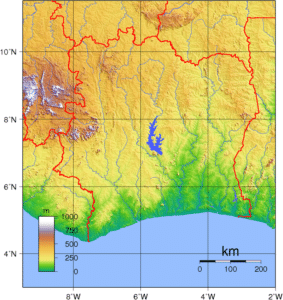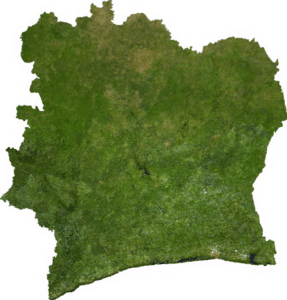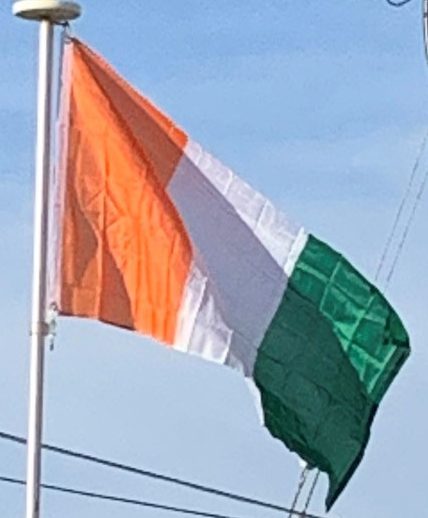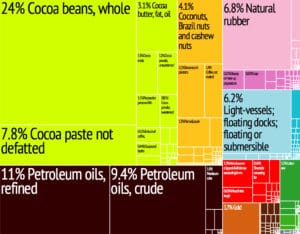
Ivory Coast’s terrain can generally be described as a large plateau rising gradually from sea level in the south to almost 500 m (1,640 ft) elevation in the north. The nation’s natural resources have made it into a comparatively prosperous nation in the African economy. The southeastern region of Ivory Coast is marked by coastal inland lagoons that starts at the Ghanaian border and stretch 300 km (186 mi) along the eastern half of the coast. The southern region, especially the southwest, is covered with dense tropical moist forest. The Eastern Guinean forests extend from the Sassandra River across the south-central and southeast portion of Ivory Coast and east into Ghana, while the Western Guinean lowland forests extend west from the Sassandra River into Liberia and southeastern Guinea. The mountains of Dix-Huit Montagnes region, in the west of the country near the border with Guinea and Liberia, are home to the Guinean montane forests.
The Guinean forest-savanna mosaic belt extends across the middle of the country from east to west, and is the transition zone between the coastal forests and the interior savannas. The forest-savanna mosaic interlaces forest, savanna and grassland habitats. Northern Ivory Coast is part of the West Sudanian Savanna ecoregion of the Tropical and subtropical grasslands, savannas, and shrublands biome. It is a zone of lateritic or sandy soils, with vegetation decreasing from south to north.

The terrain is mostly flat to undulating plain, with mountains in the northwest. The lowest elevation in Ivory Coast is at sea level on the coasts. The highest elevation is Mount Nimba, at 1,752 metres (5,748 ft) in the far west of the country along the border with Guinea and Liberia.
Economy:
Ivory Coast has, for the region, a relatively high income per capita (US$1,662 in 2017) and plays a key role in transit trade for neighboring, landlocked countries. The country is the largest economy in the West African Economic and Monetary Union, constituting 40% of the monetary union’s total GDP. The country is the world’s largest exporter of cocoa beans, and the fourth-largest exporter of goods, in general, in sub-Saharan Africa (following South Africa, Nigeria, and Angola).
In 2009, cocoa-bean farmers earned $2.53 billion for cocoa exports and were projected to produce 630,000 metric tons in 2013. According to the Hershey Company, the price of cocoa beans is expected to rise dramatically in upcoming years. Ivory Coast also has 100,000 rubber farmers who earned a total of $105 million in 2012.
Close ties to France since independence in 1960, diversification of agricultural exports, and encouragement of foreign investment have been factors in the economic growth of Ivory Coast. In recent years, Ivory Coast has been subject to greater competition and falling prices in the global marketplace for its primary agricultural crops: coffee and cocoa. That, compounded with high internal corruption, makes life difficult for the grower, those exporting into foreign markets, and the labor force, inasmuch as instances of indentured labor have been reported in the country’s cocoa and coffee production in every edition of the U.S. Department of Labor’s List of Goods Produced by Child Labor or Forced Labor since 2009.

